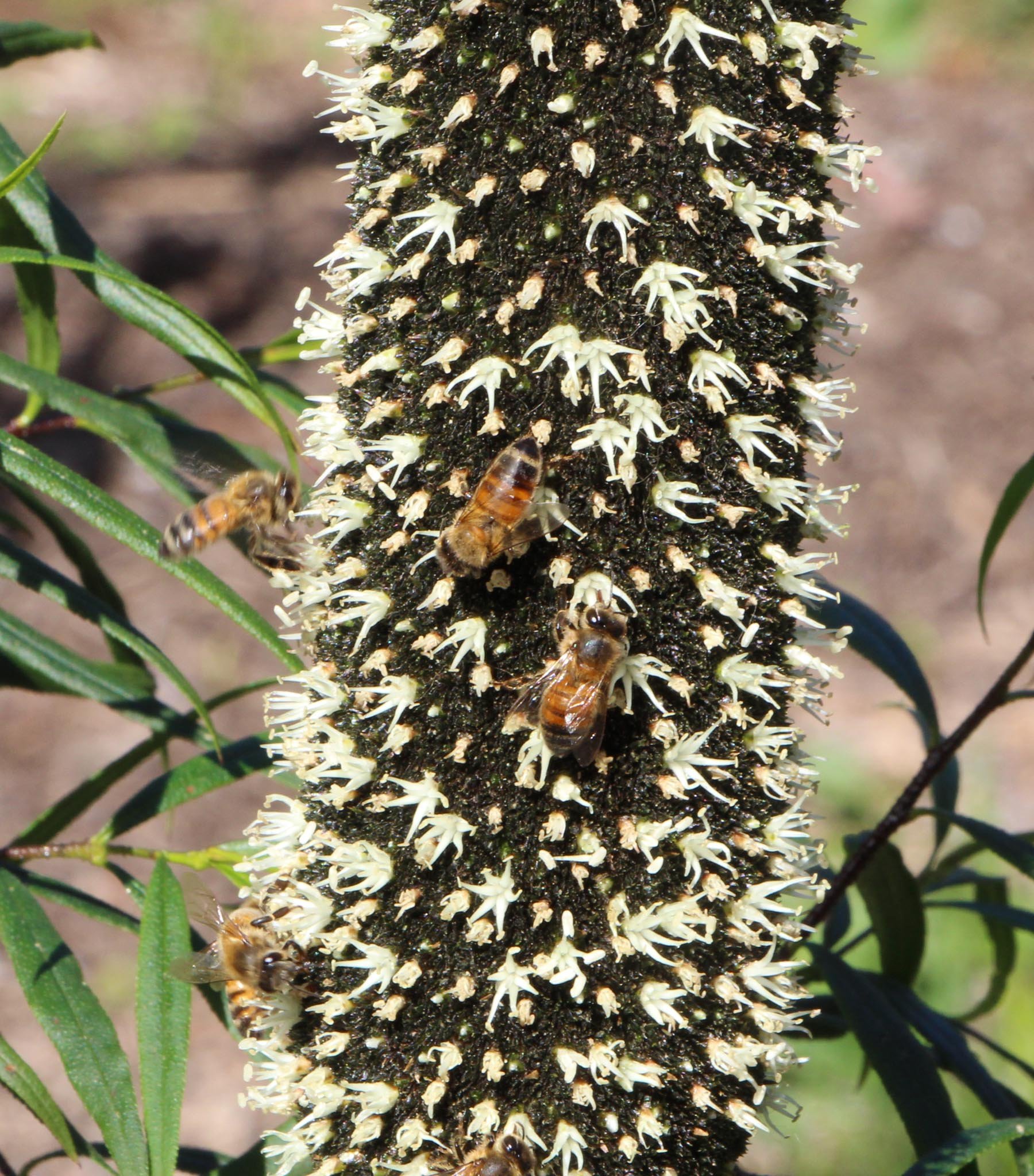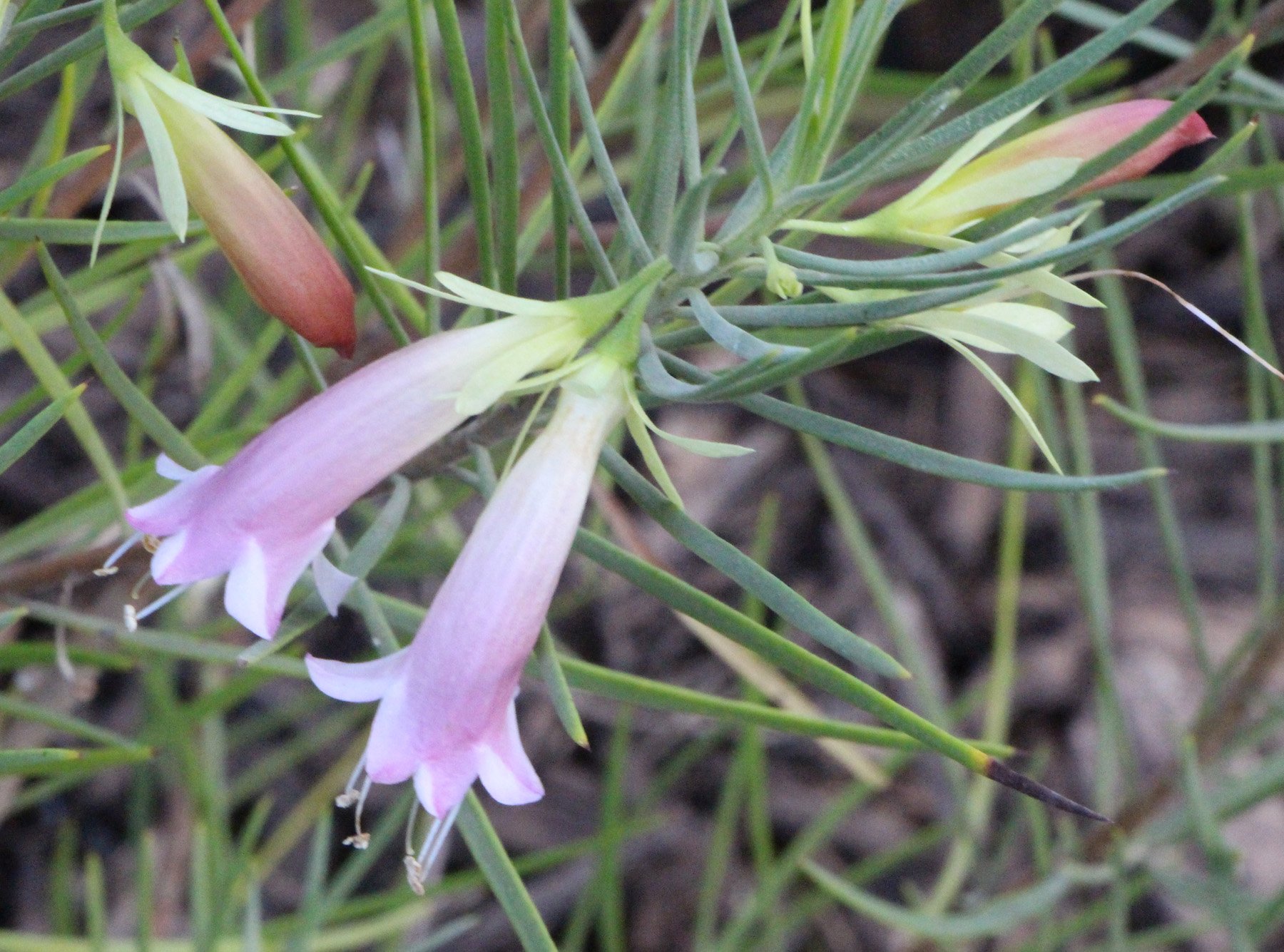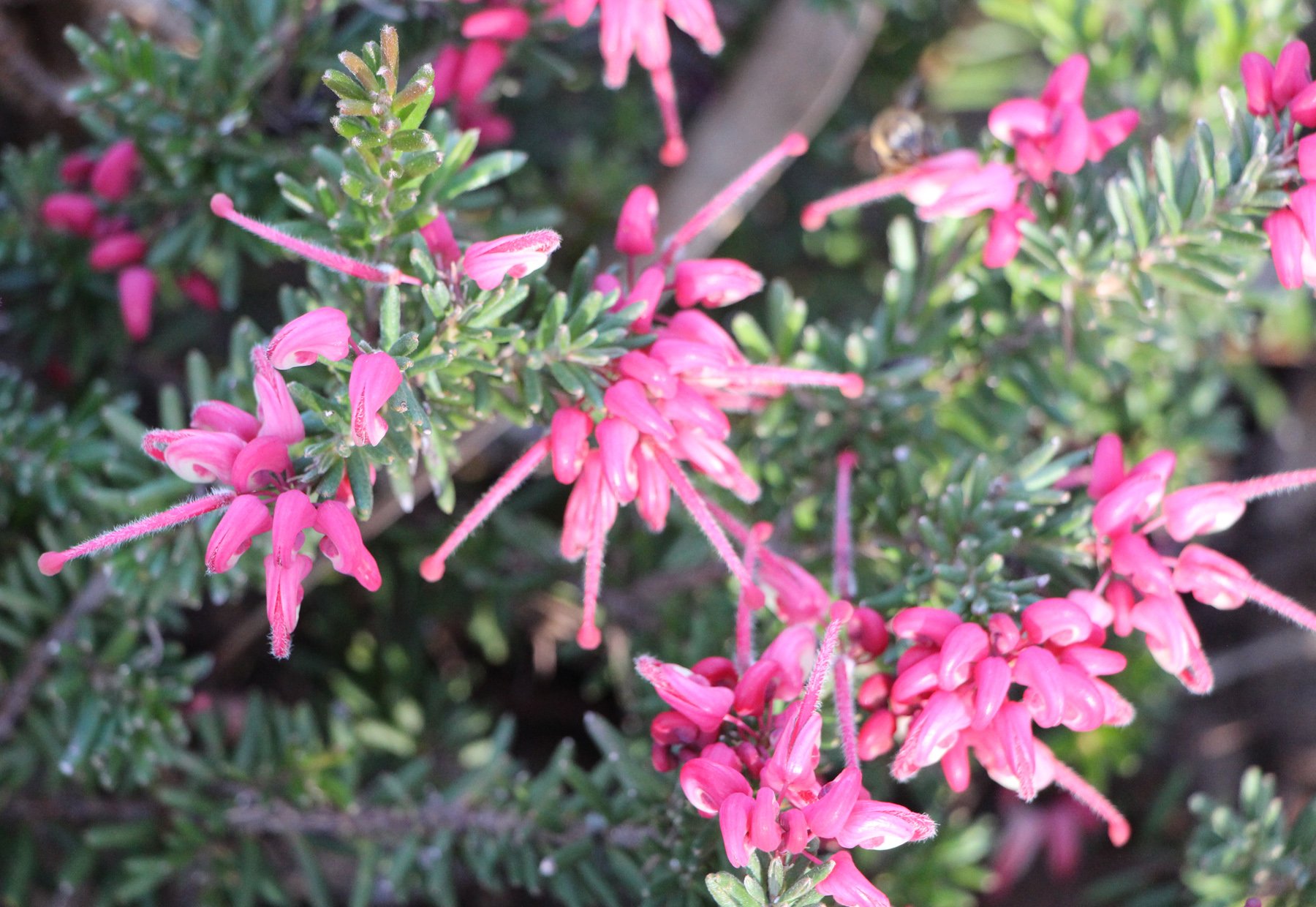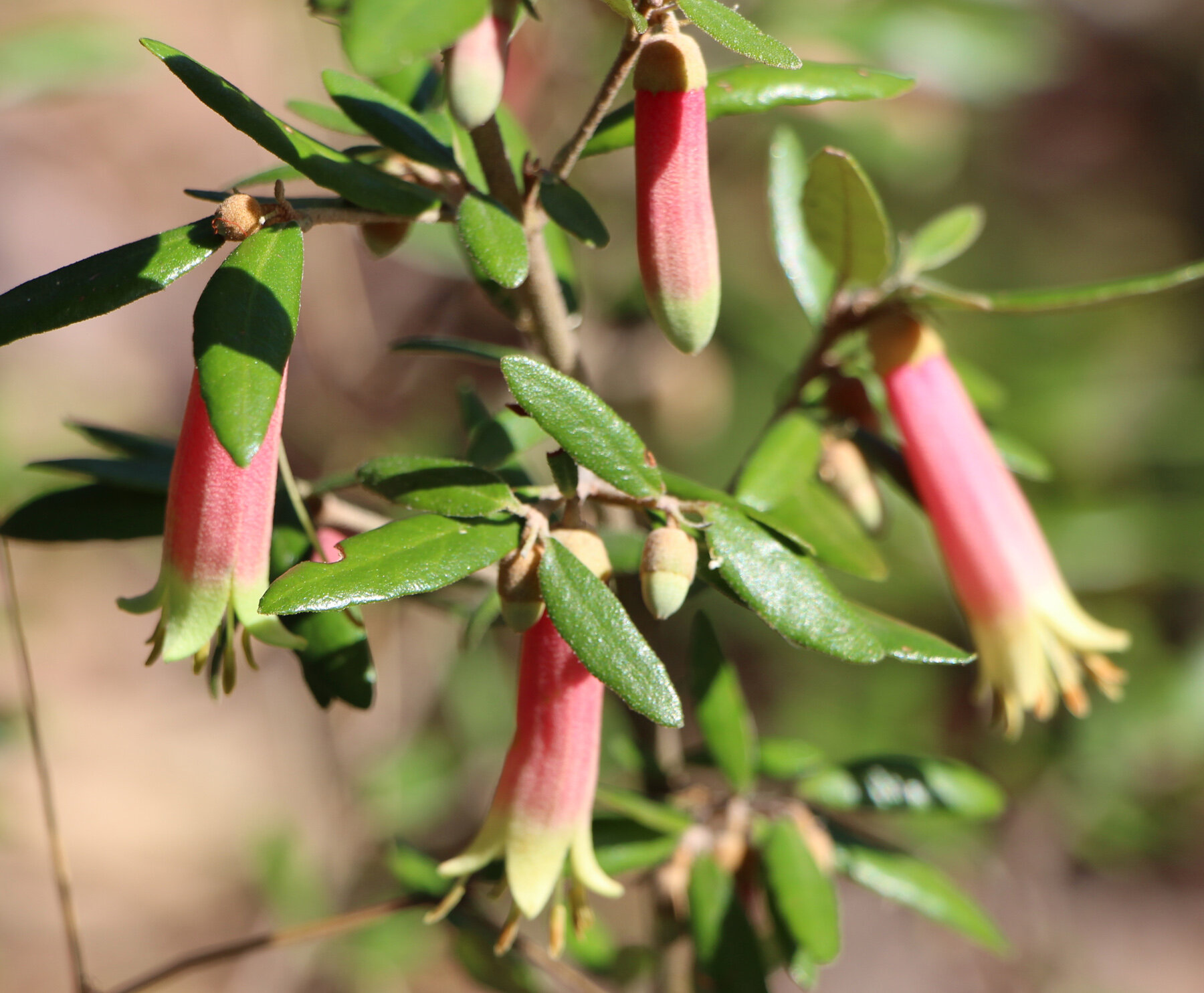June
Some plants that are in bloom in June
Click on any image to enlarge and scroll though all the images for each week.
Hakea laurina x petiolaris ‘Pin Ball’
17 June 2024
Starting from the top left:
Banksia ericifolia ‘Little Eric’
We have planted five of this compact form of classic Australian native, which was one of the first plants to be domesticated and has been grown in the UK since late 18C, from 2019-2021. This cultivar, 2m high x 1.8m wide, has cylindrical red/orange flowers and fine green heath-like foliage.
Banksia pulchella – Teasel Banksia (grafted)
We planted a grafted specimen of this plant in April 2009. The species name is from the Latin for pretty. The shrub grows to 1m high and flowers with brownish-yellow teasel flowers with unusual grey, knobbly fruiting cones. Our plant has flowered reliably since April 2010. This plant is native to the south coast of Western Australia, near Esperance. The type collection was by Robert Brown in January 1802, Lucky Bay, WA.
Correa ‘Ring A Ding Ding’
We planted eight of these compact shrubs, height 50cm x width 60cm, with glossy green foliage and many bright orange bell flowers, in August 2016.
Eremophila glandulifera ‘Lipstick Pink’ - grafted
We planted this upright shrub with attractive grey foliage and lolly pink flowers in a pot in December 2019. This plant is from central WA and grows to a height of 1.5m.
Grevillea lanigera ‘Celia’
This plant is a cultivar of Grevillea lanigera called ‘Celia’ which we planted in October 2017, February 2018 and April 2018. This low hardy shrub, 45cm high x 1m wide has pink and white flowers in winter and spring.
Phebalium nottii pink
We planted this mall bushy shrub to 1m high with dark foliage and clusters of pink star flowers in April 2021. This plant is frost and drought tolerant and is native to northern NSW and southern Queensland. The first blooms were in June 2021. We have planted another six in 2022-23.
3 June 2024
Starting from the top left:
Banksia ericifolia ‘Little Eric’
We have planted five of this compact form of classic Australian native, which was one of the first plants to be domesticated and has been grown in the UK since late 18C, from 2019-2021. This cultivar, 2m high x 1.8m wide, has cylindrical red/orange flowers and fine green heath-like foliage.
Banksia pulchella – Teasel Banksia (grafted)
We planted a grafted specimen of this plant in April 2009. The species name is from the Latin for pretty. The shrub grows to 1m high and flowers with brownish-yellow teasel flowers with unusual grey, knobbly fruiting cones. Our plant has flowered reliably since April 2010. This plant is native to the south coast of Western Australia, near Esperance. The type collection was by Robert Brown in January 1802, Lucky Bay, WA.
Correa ‘Catie Bec’
We have planted six of these shrubs, 1m x 1.5m wide, with pretty pink flowers, over the period 2018-21. In our garden they need some overhead protection. We planted five more in October 2023.
Correa 'Marian's Marvel'
We have planted 22 of this hybrid between C. backhousiana and C. reflexa, 2 m by 3 m across, from 2003-2019. This plant has dark green foliage and bell shaped flowers which are pink in upper section and lime green near the tip. Originally we took the advice that these plants liked shade and we had only mixed success with them. We then saw them growing beautifully in full sun at Murrumbateman, and tried cuttings from our original plants in a similar position. These plants have grown and flowered extremely well and frost does not bother them at all.
Correa pulchella – Wild Fuchsia
We have planted 15 of these correas, 1m x 1m, with decorative salmon bell flowers from 2005-19. This small neat shrub from South Australia provides great winter color, and prefers moist well drained soils in a sunny to partly shaded position.
Hakea laurina x petiolaris ‘Pin Ball’ – Pincushion Hakea (grafted)
‘Pin Ball’ is a standout shrub in our garden, with leathery green to bluish green leaves with prominent veining and ball like red flowers with cream styles. We have planted four of these shrubs, 3.5 – 5m high x 3-10m wide.
19 June 2023
Starting from the top left:
Acacia beckleri - Barrier Range Wattle
We have planted three of these shrubs to 3m high, often spreading widely, native to the Gawler Range and the northeastern Eyre Peninsula, SA, then further east to Cobar and Jerilderie NSW. The first one, planted November 2013, died December 2014, but the other two are persisting and flowering 3/21.
Banksia ‘Bird Song’
We planted three of these hybrids, B. spinulosa ‘dwarf’ x ericifolia ‘Golden Girl’ in August 2013. These are hardy banksias, height 1.5m x 1.5m, which flower prolifically throughout autumn and winter with shiny green foliage and orange spikes of flower. Honeyeaters love this plant.
Correa ‘Catie Bec’
We have planted six of these shrubs, 1m x 1.5m wide, with pretty pink flowers, over the period 2018-21. In our garden they need some overhead protection.
Correa ‘Ring A Ding Ding’
We planted eight of these compact shrubs, height 50cm x width 60cm, with glossy green foliage and many bright orange bell flowers, in August 2016.
Grevillea ‘Lady O’
Grevillea ‘Lady O’ is Ben’s favourite plant in our garden because it always looks healthy and never stops flowering. This plant is a hybrid between a Grevillea victoriae hybrid and Grevillea rhyolitica and has light green foliage and prolific red flowers. ‘Lady O’ was bred at Bywong Nursery and named after Peter Ollerenshaw’s mother. The bushy plant grows to 2m high and wide. We planted our first ‘Lady O’ in April 2004 and have planted 13 since then over the five years to 2009. This plant is a fabulous performer in our garden.
Xanthorrhorea quadrangulata - Yucca
We planted nine of these slow growing grass like shrubs with tall flower spikes as tubestock from Australian Arid Lands Botanic Gardens, in September 2017. These plants are endemic to South Australia. All nine are growing slowly and this year, 2023, four have flowered. Three more flowered in 2022.
5 June 2023
Starting from the top left:
Banksia ‘Yellow Wing’
We planted nine of these banksia hybrids in 2006, Banksia ‘Giant Candles’ x B. spinulosa (Carnarvon Gold) ‘Birdwire’. They form a rounded shrub, 1.5-1.8m x 1.5x1.8m wide, with fine dense foliage and many orange nectar-rich flowers. The flower spikes are held well above the foliage which attracts a range of nectar eating birds, and parrots love their seed.
Correa ‘Coastal Pink’
We have planted seven plants of this form of Correa alba with pink flowers, growing to 2m x 2m, but only three remain.
Correa sp. hybrid (lemon)
We planted five of these prostrate shrubs, 0.2-0.5m high x 0.5- 1m wide, with dark green leaves and short wide creamy lemon flowers in October 2018. We have three remaining as two died in the heat of January 2020.
Eremophila glandulifera ‘Lipstick Pink’ - grafted
We planted this upright shrub with attractive grey foliage and lolly pink flowers in a pot in December 2019. This plant is from central WA and grows to a height of 1.5m.
Eremophila oldfieldii ssp. angustifolia x E. oppositifolia ‘Piccaninny Dawn’
We have planted three of these compact shrubs, 3m high x 3m wide, with dark grey leaves and rose pink flowers, in 2011, 2018 and 2020. This plant will grow in a variety of soils, is drought tolerant and is somewhat tolerant of frost. Our first plant died after -6 deg. C. frost in June 2012. We have placed the other two under more overhead protection and they are flowering well.
Grevillea ‘Winter Kiss’
We planted this low ground coverer, 0.15m high x 1m wide, with small bright green leaves and many red and cream spider flowers, in February 2015. This is a hardy plant and attractive to birds.
27 June 2022
Starting from the top left:
Adenanthos meissneri – Prostrate Woollybush
We planted three of these low growing spreading shrubs 1.5m high x 2m wide, with grey green hairy foliage and small red tubular flowers, in February 2011. These do get somewhat frost damaged in winter, even though they are growing under Grevillea insignis, which gives them some protection. This plant is native to southwestern WA.
Correa ‘Catie Bec’
We have planted six of these shrubs, 1m x 1.5m wide, with pretty pink flowers, over the period 2018-21. In our garden they need some overhead protection.
Correa ‘Ring A Ding Ding’
We planted eight of these compact shrubs, height 50cm x width 60cm, with glossy green foliage and many bright orange bell flowers, in August 2016.
Hakea clavata
We have planted two of these shrubs, 1.5m high x 2.5m wide, with succulent like leaves and pale pink to white flowers, in March 2012 and November 2019. The foliage is unusual and a feature of the plant. Our first specimen, planted in March 2012, was hit by the frost in October of the same year and died. The second one we planted in pot in November 2019 and it is growing well so far and flowered for the first time in October 2021. This plant is native to the Esperance area of WA and is adapted to harsh conditions.
Hakea coriacea - Pink Spike Hakea
We have planted four Hakea coriacea, or Pink Spike Hakea, the first three in the garden, all of which met a sticky end. Two of them were blown over in the wind. They were rotted out at the base as our garden is a bit too wet for them. This shrub, 2-4m high and 2-3m wide, with grey-green leathery leaves and pink spikes of flower, comes from the Kalgoorlie area of WA. We planted one in a pot in November 2013 then moved it into the garden in December 2016. This plant is now 3m high and has bloomed sparingly. I could wish for more blooms. Many more blooms arrived in spring 2021 with the extra La Nina rain.
Paraserianthes lophantha – Cape Leeuwin Wattle or Plume Albizia
We planted this fast growing tree to 10m high, with fine bipinnate foliage and iridescent yellow-green toothbrush flowers, in January 2021. This plant is native to southwestern WA, from Fremantle to King George Sound. While it is strictly neither a wattle nor an albizia despite its common names, this tree has grown to 3m high and is flowering for the first time in April 2022. I have placed this plant in a very protected area with lots of sun, it has made it through one Canberra winter and I have high hopes that it will continue to cope.
20 June 2022
Starting from the top left:
Banksia pulchella – Teasel Banksia (grafted)
We planted a grafted specimen of this plant in April 2009. The species name is from the Latin for pretty. The shrub grows to 1m high and flowers with brownish-yellow teasel flowers with unusual grey, knobbly fruiting cones. Our plant has flowered reliably since April 2010. This plant is native to the south coast of Western Australia, near Esperance. The type collection was by Robert Brown in January 1802, Lucky Bay, WA.
Banksia ericifolia ‘Red Rover’
We planted one of these plants in our large rockery in November 2006. This plant has grown much larger than its advertised 1..8m high x 1.2m wide, more like 3m high x 6m wide, with bright red flower spikes and fresh green needle foliage. Our plant began flowering in May 2010, but did not show bright red brushes until it became more mature.
Correa glabra ‘Ivory Beacon’
We planted this selected form of Correa glabra, height 0.5 – 1m and width 0.5 – 1m, with many ivory bells in August 2018.
Eremophila oldfieldii ssp. angustifolia x E. oppositifolia ‘Piccaninny Dawn’
We have planted three of these compact shrubs, 3m high x 3m wide, with dark grey leaves and rose pink flowers, in 2011, 2018 and 2020. This plant will grow in a variety of soils, is drought tolerant and is somewhat tolerant of frost. Our first plant died after -6 deg. C. frost in June 2012. We have placed the other two under more overhead protection and they are flowering well.
Eremophila youngii
We have planted two of these upright shrubs, 1-2m high x 0.6-1m wide, with attractive grey foliage and tubular pink flowers, in 2010 and 2012. This plant is native to central WA. One died in April 2021, but the other is now over 2m high and blooms often.
Grevillea ‘Emma Charlotte’
We planted this hybrid grevillea, 0.5m high x 1m wide, a cross between G. rosmarinifolia and G. lanigera, in June 2008 The flowers are deep pink and attractive to birds.
13 June 2022
Starting from the top left:
Acacia subulata – Awl Wattle
We planted this small tree, 1.5 – 4m high and 1-2m wide, with a slender habit, narrow graceful foliage and showy yellow ball flowers, in August 2016. This plant is native to northeastern NSW along the ranges and slopes. This wattle blooms all year, in a serial fashion, from branch tip upwards, smells delicious, has delightful light ferny foliage, decorative seed pods and grows fast.
Correa sp. hybrid (lemon)
We planted five of these prostrate shrubs, 0.2-0.5m high x 0.5- 1m wide, with dark green leaves and short wide creamy lemon flowers in October 2018. We have three remaining as two died in the heat of January 2020.
Correa ‘Ring A Ding Ding’
We planted eight of these compact shrubs, height 50cm x width 60cm, with glossy green foliage and many bright orange bell flowers, in August 2016.
Grevillea ‘Lady O’
Grevillea ‘Lady O’ is Ben’s favourite plant in our garden because it always looks healthy and never stops flowering. This plant is a hybrid between a Grevillea victoriae hybrid and Grevillea rhyolitica and has light green foliage and prolific red flowers. ‘Lady O’ was bred at Bywong Nursery and named after Peter Ollerenshaw’s mother. The bushy plant grows to 2m high and wide. We planted our first ‘Lady O’ in April 2004 and have planted 13 since then over the five years to 2009. This plant is a fabulous performer in our garden.
Grevillea ‘Lemon Daze’
We have unfortunately had many failures with Grevillea ‘Lemon Daze’, a 1m x1m shrub, with bright yellow and pink pendulous flowers, again a Bywong Nursery selection. We planted three in April 2009, then six in June 2009, one in February 2010, one January 2011, three May 2015 and another in September 2015. We have really tried to get this plant established in our garden in many different positions. I believe that we now have one remaining, which is finally growing and flowering well and is a very attractive grevillea. However, the others often had yellowing foliage, which we treated with iron chelates, died suddenly, or failed to thrive in our garden.
Grevillea ‘Woolly Bear Hero’
Grevillea ‘Woolly Bear Hero’ is a selection of G. lanigera, a low plant about 1m wide, with attractive grey-green foliage and dark pink flowers over a long period. We have planted five of them over a five year period, 2010-15, in various parts of the garden and they perform well.
6 June 2022
Sarting from the top left:
Eremophila oldfieldii ssp. angustifolia x E. oppositifolia ‘Piccaninny Dawn’
We have planted three of these compact shrubs, 3m high x 3m wide, with dark grey leaves and rose pink flowers, in 2011, 2018 and 2020. This plant will grow in a variety of soils, is drought tolerant and is somewhat tolerant of frost. Our first plant died after -6 deg. C. frost in June 2012. We have placed the other two under more overhead protection and they are flowering well.
Eremophila oppositifolia purple
We planted this shrub, 1.5m high x 1-2m wide, with grey-green linear leaves and purple flowers with prominent white calyces, in March 2012. This plant was originally not in enough sun, but now receives more light and has flowered well every year since 2017.
Hakea laurina ‘Stockdale Sensation’
Hakea laurina ‘Stockdale Sensation’ is a cultivar with a dense weeping habit and pink and cream pincushion flowers. We have planted three of these in various places in the garden, in September 2014 and 2015. All three are thriving and flowering somewhat. We hope for more blooms as these shrubs mature.
Hakea laurina x petiolaris ‘Pin Ball’ – Pincushion Hakea (grafted)
‘Pin Ball’ is a standout shrub in our garden, with leathery green to bluish green leaves with prominent veining and ball-like red flowers with cream styles. We have planted three of these shrubs, 3.5 – 5m high x 3-10m wide.
Templetonia retusa (prostrate form) – Cockies Tongues
We planted this spreading shrub, 1m high x 2m wide, with rounded green leaves and large red pea flowers, in October 2010. These plants do well with sharp drainage, full sun to semi-shade, and the addition of some lime. Ben made three cuttings and these were planted in September 2015. This plant is native to coastal limestone strip of SA and WA, also Flinders Ranges, SA. These are the slowest plants to grow in the garden.
7 June 2021
Starting from the top left:
Hakea francisciana ‘Pomonal Pink’
Hakea francisciana ‘Pomonal Pink’ is a grafted, tall woody shrub with narrow grey leaves and spectacular long pink brush flowers in winter and spring. This plant can eventually grow to 5m high and wide, but so far the one we planted in our garden, in September 2013, is 3m high and 2m wide, with an attractive oval shape. This plant first flowered for us in October 2014 and has continued to flower each year with more and more flowers. As this plant was such a success we bought another grafted specimen in November 2017, but this plant has turned to have green leaves, and so far, no flowers. It remains to be seen whether this plant will bloom with the same showy flowers.
Correa ‘Ice Chimes’
We planted three of these compact shrubs, height 0.75m x width 0.5m, with dense foliage and many white dainty bell flowers, in November 2019.
Correa ‘Coastal Pink’
We have planted seven plants of this form of Correa alba with pink flowers, growing to 2m x 2m, but only three remain.
Androcalva loxophylla (Rulingia kempeana)
We have planted five of these erect shrubs, 1.5m high x 1.5m wide, with small hairy green leaves with toothed margins and bright yellow flowers at the base of leaves, over the period 2015-18. This plant is native to WA, SA, NT and Queensland.
Banksia ‘Bulli Baby’
B. ericifolia nana. This dwarf banksia originated in the Bulli area and grows to only 1-2m high., with fine linear bright green leaves and spectacular orange-red spikes during autumn and winter. These flower spikes can be p to 20cm long and are abundant. This plant prefers a sunny to partly shaded position in well drained soil. Lightly prune and remove spent flowers.
Grevillea speciosa
We planted Grevillea speciosa, or Red Spider Flower, in October 2009 and it has grown to a large bush 1.5m high and 2m wide with bright red flowers, not all year as advertised, but for a long period from late winter through summer. This plant comes from the greater Sydney area and has slightly prickly leaves which form a bushy haven for small birds. We also grow Grevillea speciosa x oldei which we planted in 2015. This small spreading shrub grows to 1m high and 1.5m across with many dark pink flowers over a long period.
14 June 2021
starting from the top left:
Alyogyne huegelii ‘Misty’
We planted three of these shrubs, with attractive bluish foliage and many lilac flowers with burgundy centres, in December 2018. These plants bloom very generously over several months.
Banksia spinulosa ‘Coastal Cushion’
We planted three of these small shrubs, 50cm high and 1.5m across, with lush green foliage and yellow cone flowers with maroon styles, in October 2014. One did not thrive and was replaced in January 2021, but the others are flowering well.
Correa ‘Summer Belle’
We have planted five of these spreading shrubs, 1m high x 1.5m wide, with shiny dark green leaves and pink flowers with green tips. This plant arose as a garden seedling from Neil Marriott of Stawell, Victoria.
Crowea saligna ‘Large Flower’
We planted three of these small shrubs in pots, 80cm high x 60cm wide, with large pink flowers and aromatic foliage. Native bees and butterflies are attracted to this plant.
Grevillea ‘Carol Ann’
We have planted three Grevillea ‘Carol Ann’, a decumbent, hardy plant, 2 m wide, with dark green foliage and red spider flowers, the first in 2013, then two more in 2016. We have grown one drooping most effectively over a wall. These plants bloom generously for a very long period.
Grevillea ‘Waverley Ghost’
We planted Grevillea 'Waverley Ghost', a variegated sport from a potted specimen of Grevillea 'Poorinda Constance' in the nursery of the Victorian State Schools Horticultural Society in Glen Waverley, Victoria, in September 2014. This cultivar forms a dense, bushy shrub to 1.5m high and from 1.5 to 2m wide with variegated cream and light green foliage and red flowers.
21 June 2021
Starting at the top left:
Banksia pulchella – Teasel Banksia (grafted)
We planted a grafted specimen of this plant in April 2009. The species name is from the Latin for pretty. This shrub grows to 1m high and flowers with brownish-yellow teasel flowers with unusual grey, knobbly fruiting cones. Our plant has flowered reliably since April 2010. This plant is native to the south coast of Western Australia, near Esperance. The type collection was by Robert Brown in January 1802, Lucky Bay, WA.
Correa ‘Jetty Red’
We have planted six of this selected compact form of C. reflexa., with striking red bell shaped flowers, three in March 2016 and three in February 2021. Unfortunately only one remains of the first planting and all three correas died in the first week after the second planting. However, the one that remains is healthy and has beautiful flowers
Correa ‘Mallee Pastel’
We planted two of these groundcover shrubs, height 30cm x width 1m, with pastel pink flowers, in 2016. Both have grown well and flower reliably each year.
Eucalyptus pulverulenta
We planted this twisted tree, height to 8m, with silver-grey stem-clasping foliage and white flowers, in October 2014. This plant is native to the area between Bathurst and Bombala, NSW.
Grevillea lanigera ‘Celia’
We planted three of these low hardy shrubs, 45cm high x 1m wide, with pink and white flowers, in 2018. This plant needs full sun and is frost hardy, and the flowers attract birds.
Spyridium parvifolium – Dusty Miller
We planted three of these shrubs in February 2019, 50cm high x 1.5m wide, with ornamental foliage, unusual brown flowers and white floral leaves which are profuse and well displayed in winter and spring. This shrub is native to southeastern Australia, including Tasmania.
28 June 2021
Starting from the top left:
Phebalium nottii
We planted this mall bushy shrub to 1m high, with dark foliage and clusters of pink star flowers, in April 2021. This plant is frost and drought tolerant and is native to northern NSW and southern Queensland. Our first blooms were in June 2021.
Grevillea ‘Crackles’
We planted this small shrub, 1m x 1m, with a prolific display of red and yellow flowers, in October 2019. This plant is a bee and bird attractor, needs full sun and is frost tolerant.
Grevillea ‘Crimson Villea’
We planted this compact grevillea with masses of showy crimson winter flowers, 80cm x 80cm, in February 2020. This cultivar of G. rosmarinifolia had its first flowers for us in September 2020.
Grevillea ‘Knockout’
Grevillea ‘Knockout’ is another Bywong Nursery selection that we planted in October 2017, February 2018 and August 2019. This small, 1m x 1m, plant has very dark green leaves and orange-yellow flowers.
Grevillea ‘Winter Delight’
Grevillea ‘Winter Delight’ is a hybrid between. G. lanigera prostrate x G. lavandulaceae, which develops into a low shrub 30cm high x 1m across, with soft grey foliage and red, pink and cream flowers in winter and spring. We planted six in March 2008, and replaced one in April 2017, but many of them are not thriving.
Grevillea ‘Lady O’
Grevillea ‘Lady O’ is Ben’s favourite plant in our garden because it always looks healthy and never stops flowering. This plant is a hybrid between a Grevillea victoriae hybrid and Grevillea rhyolitica and has light green foliage and prolific red flowers. ‘Lady O’ was bred at Bywong Nursery and named after Peter Ollerenshaw’s mother. The bushy plant grows to 2m high and wide. We planted our first ‘Lady O’ in April 2004 and have planted 13 since then over the five years to 2009. This plant is a fabulous performer in our garden.








































































